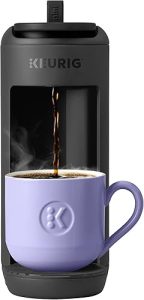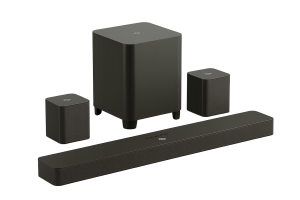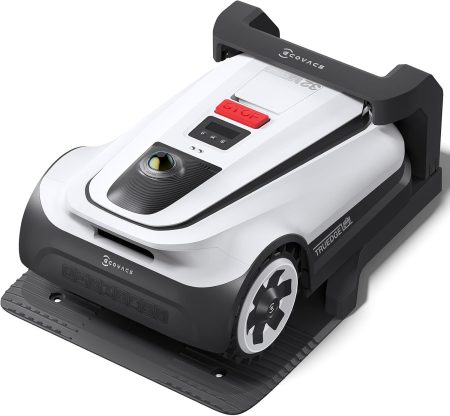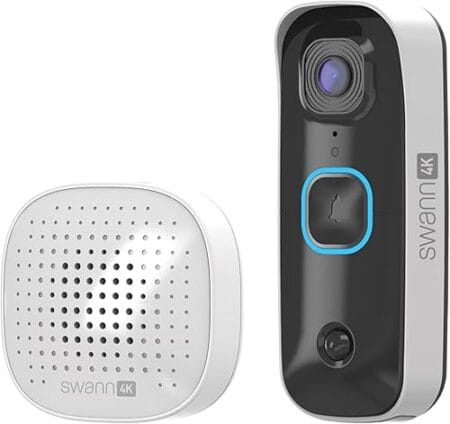The Hisense U8 TV line has been one of our favorites for a few years. The U8QG, new for 2025, emits even more light than the exceptionally bright U8N from the previous year. Additionally, it boasts a 4.1.2-channel spatial audio speaker system, more accurate color reproduction, and a handy side-mounted USB-C connector that supports 4K165 video over DisplayPort. But it’s not all improvements; it costs significantly more than the U8N and loses one of the three HDMI ports. Although the retail price of the 65-inch model we tested is a hefty $2,199.99 for Hisense, you’ll probably find it for the far more reasonable and officially recognized “everyday price” of $1,499.99 ($350 more than the previous version).
Design
With no bezel on the top or sides and a thin brushed metal strip running the length of the bottom edge with a bump in the center for the far-field microphone array, power/input button, and indicator LED, the U8QG adopts a conventional design approach from the front. You will notice a distinctive characteristic if you look to the side. While the flat top panel has grilles for the upward-firing drivers, the left and right sides of the TV have deep grooves running down their lengths for the side-firing speaker drives (and, on the left, a USB-C connector with DisplayPort support for convenient device connection). Although the U8QG isn’t the thinnest high-end TV on the market, it does have a 4.1.2-channel sound system.
The U8QG rests on a flat, octagonal metal table stand that has two height settings based on which screw holes you use to connect it to the TV, unless you want to mount it on the wall.
Almost every connector on the U8QG is located in a rectangular recess close to the left edge, facing left. They have two USB-A ports, three HDMI ports (one eARC), a headphone output, a 3.5mm composite input, serial control jacks, an Ethernet port, an optical audio output, and an antenna/cable RF connector.
There is another high-end video input option available, but it’s strange that this TV only has three HDMI connections when practically all others have four. With just one wire, you can connect the majority of PCs, Android phones, and contemporary iPhones and iPads to the TV directly thanks to the USB-C port on the left edge, which enables DisplayPort video at up to 4 K165. However, unlike the HDMI connections, it does not support HDR.
A fourth HDMI port is still necessary if you want to keep three gaming devices (such as a Nintendo Switch, PlayStation 5, and Xbox Series X) continuously connected to the TV along with a soundbar. The side USB-C port is handy if you need an easily accessible wired video connection for some devices. Since accessing the port requires a cable to protrude from the left side of the TV, it is obvious that this port is not for any semi-permanent connection. Additionally, the U8QD’s easy-access video connection seems a little unnecessary given that it already supports wireless streaming with Google Cast and Apple AirPlay on Android, iOS, and Chrome tabs.

The remote control is a flat plastic bar with a silver circular navigation pad near the center, backlit buttons, and a brushed metallic gray finish. A pinhole microphone, power, input, settings, user profiles, and Google Assistant buttons are located above the pad. There are also service buttons for YouTube, Netflix, Disney+, Amazon Prime Video, and Tubi, as well as a sixth customized shortcut. Below the pad are controls for playback, menu navigation, volume, and channel rockers.
Sound
Although we don’t usually test TV speakers, the U8QG’s 4.1.2-channel sound system deserves recognition for its integrated height and side-firing channels as well as Dolby Atmos spatial audio capabilities. A step up over the U8N’s 2.1.2-channel speaker system, it has an audio setup akin to the Hisense U9N. With a maximum power of 66W for the 55-inch model, 72W for the 65-inch one I tested, and 82W for the 100-inch model, its output varies according to screen size. Compared to other built-in stereo TV speakers, it will most likely provide a better sound experience. However, since the TV’s speaker system and a soundbar with those characteristics are incompatible, you will have to forgo the TV’s speaker system if you truly want back channels or rumbling.
Software
The Google TV smart TV platform is used by the U8QG, just like by Hisense’s other ULED TVs. As usual, it’s a feature-rich interface that supports all of the main streaming services, such as YouTube, Netflix, Twitch, Disney+, Crunchyroll, Apple TV, and Amazon Prime Video. Additionally, Hisense incorporates Apple AirPlay into its implementation for local streaming from iPhones, iPads, and Macs, and the platform has Google Cast by default for local streaming from Android devices and Chrome tabs.
Google Assistant is integrated into Google TV, and the U8QG can be used hands-free thanks to its far-field microphone array. It enables voice control of the TV and any other smart home gadgets that are compatible with Google Home. Additionally, you can set alarms and reminders, obtain basic information, and do content searches. By pressing a button on the remote control and speaking into the voice assistant, you can turn off the microphone array and still use your TV if you don’t want it to constantly listen for a wake word.
Picture Quality
A 4K QLED mini-LED TV with a native refresh rate of 165 Hz is the Hisense U8QG. It supports HDR10, HDR10+, hybrid log gamma (HLG), and high dynamic range (HDR) in Dolby Vision. It boasts an ATSC 3.0 tuner for 1080p and 4K over-the-air broadcasts and Wi-Fi 6E connectivity.
I use the Calman software from Portrait Displays, a Klein K-10A colorimeter, and a Murideo SIX-G signal generator to evaluate TVs. The U8QG is incredibly bright, reaching a maximum brightness of 3,200 nits with an 18% field and 845 nits with a full-screen white field in HDR Theater mode with an HDR signal. That nearly matches the current brightness champion, the TCL QM851G (3,308 nits, 18% field), and is noticeably brighter than the U8N (2,755 nits, 18% field) and the TCL QM7K (2,092 nits, 18% field).
Conclusion
The Hisense U8QG provides outstanding gaming performance, wide and accurate color reproduction, and extreme brightness. Its USB-C port on the side, which is compatible with DisplayPort, makes connecting devices easier than with most other TVs, but that ease of use doesn’t excuse taking out the HDMI port on the back. You’ll likely require a TV with a fourth HDMI connector if you wish to connect a speaker and several game consoles. Otherwise, we like its feature-rich Google TV implementation for streaming media (as well as mirroring Google Cast and Apple AirPlay) and its 4.1.2-channel speaker system. Because it costs more than the previous generation, we’re giving it a little lower score, but the U8QN is still a great value and deserving of our Editors’ Choice designation.






